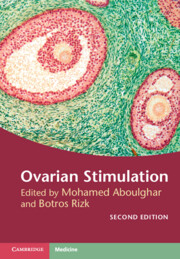Book contents
- Ovarian Stimulation
- Ovarian Stimulation
- Copyright page
- Dedication
- Contents
- Contributors
- About the Editors
- Foreword
- Preface to the first edition
- Preface to the second edition
- Section 1 Mild Forms of Ovarian Stimulation
- Section 2 Ovarian Hyperstimulation for IVF
- Section 3 Difficulties and Complications of Ovarian Stimulation and Implantation
- Section 4 Non-conventional Forms Used during Ovarian Stimulation
- Section 5 Alternatives to Ovarian Hyperstimulation and Delayed Transfer
- Section 6 Procedures before, during, and after Ovarian Stimulation
- Chapter 26 Ultrasound Monitoring for Ovulation Induction: Pitfalls and Problems
- Chapter 27 The Use of GnRH Agonists to Trigger Final Oocyte Maturation during Controlled Ovarian Stimulation
- Chapter 28 The Luteal Phase Support in In Vitro Fertilization
- Chapter 29 Luteal Phase Support Other than Progesterone
- Chapter 30 Ovarian Reserve as a Guide for Ovarian Stimulation
- Index
- References
Chapter 30 - Ovarian Reserve as a Guide for Ovarian Stimulation
from Section 6 - Procedures before, during, and after Ovarian Stimulation
Published online by Cambridge University Press: 14 April 2022
- Ovarian Stimulation
- Ovarian Stimulation
- Copyright page
- Dedication
- Contents
- Contributors
- About the Editors
- Foreword
- Preface to the first edition
- Preface to the second edition
- Section 1 Mild Forms of Ovarian Stimulation
- Section 2 Ovarian Hyperstimulation for IVF
- Section 3 Difficulties and Complications of Ovarian Stimulation and Implantation
- Section 4 Non-conventional Forms Used during Ovarian Stimulation
- Section 5 Alternatives to Ovarian Hyperstimulation and Delayed Transfer
- Section 6 Procedures before, during, and after Ovarian Stimulation
- Chapter 26 Ultrasound Monitoring for Ovulation Induction: Pitfalls and Problems
- Chapter 27 The Use of GnRH Agonists to Trigger Final Oocyte Maturation during Controlled Ovarian Stimulation
- Chapter 28 The Luteal Phase Support in In Vitro Fertilization
- Chapter 29 Luteal Phase Support Other than Progesterone
- Chapter 30 Ovarian Reserve as a Guide for Ovarian Stimulation
- Index
- References
Summary
Ovarian reserve refers to the number and quality of oocytes present in the ovaries of a woman at a given time and is thought to reflect her ability to respond adequately to ovarian stimulation [1;2]. The term was developed in the context of assisted reproduction to differentiate between poor, normal, and hyper-responders to controlled ovarian stimulation (COS). Although the term is also applicable to anovulatory women treated for infertility with ovarian stimulation, it is mainly used to describe women receiving COS as a part of an in vitro fertilization (IVF) or intracytoplasmic sperm injection (ICSI) stimulation protocol.
- Type
- Chapter
- Information
- Ovarian Stimulation , pp. 311 - 318Publisher: Cambridge University PressPrint publication year: 2022



